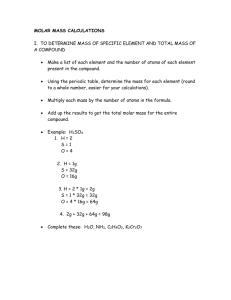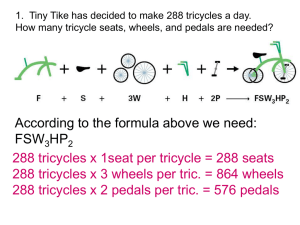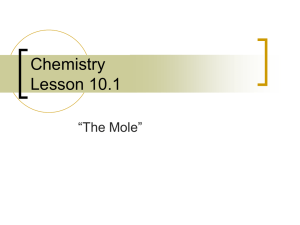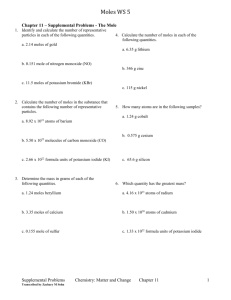Mole Lab
advertisement
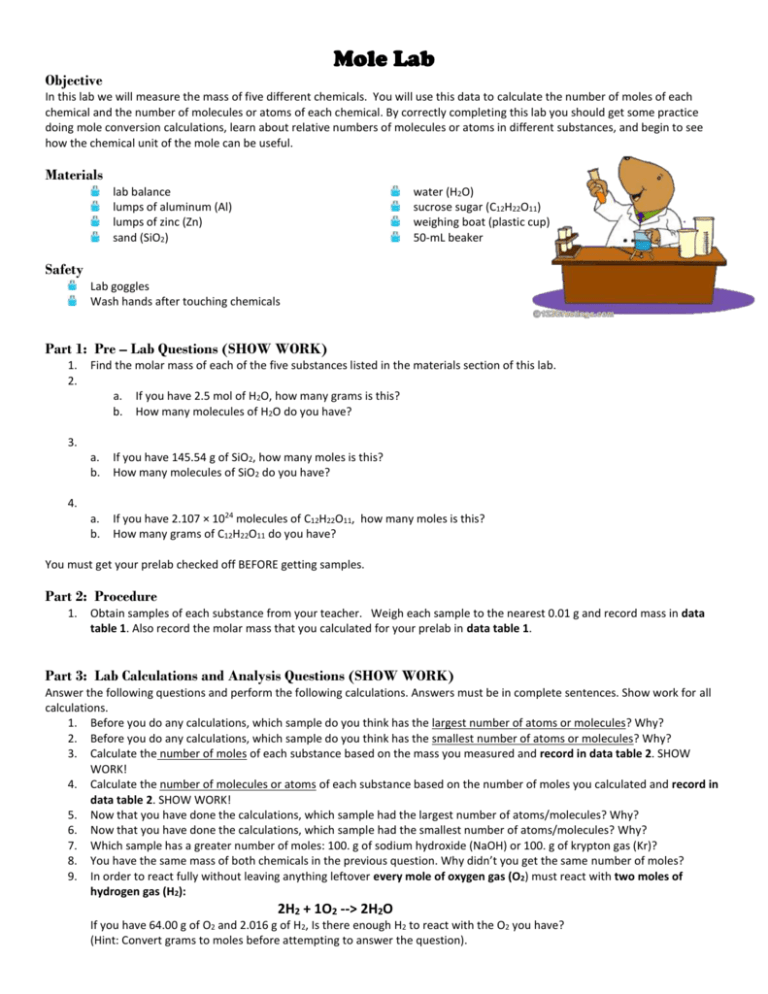
Mole Lab Objective In this lab we will measure the mass of five different chemicals. You will use this data to calculate the number of moles of each chemical and the number of molecules or atoms of each chemical. By correctly completing this lab you should get some practice doing mole conversion calculations, learn about relative numbers of molecules or atoms in different substances, and begin to see how the chemical unit of the mole can be useful. Materials lab balance lumps of aluminum (Al) lumps of zinc (Zn) sand (SiO2) water (H2O) sucrose sugar (C12H22O11) weighing boat (plastic cup) 50-mL beaker Safety Lab goggles Wash hands after touching chemicals Part 1: Pre – Lab Questions (SHOW WORK) 1. 2. Find the molar mass of each of the five substances listed in the materials section of this lab. a. b. If you have 2.5 mol of H2O, how many grams is this? How many molecules of H2O do you have? 3. a. b. If you have 145.54 g of SiO2, how many moles is this? How many molecules of SiO2 do you have? a. b. If you have 2.107 × 1024 molecules of C12H22O11, how many moles is this? How many grams of C12H22O11 do you have? 4. You must get your prelab checked off BEFORE getting samples. Part 2: Procedure 1. Obtain samples of each substance from your teacher. Weigh each sample to the nearest 0.01 g and record mass in data table 1. Also record the molar mass that you calculated for your prelab in data table 1. Part 3: Lab Calculations and Analysis Questions (SHOW WORK) Answer the following questions and perform the following calculations. Answers must be in complete sentences. Show work for all calculations. 1. Before you do any calculations, which sample do you think has the largest number of atoms or molecules? Why? 2. Before you do any calculations, which sample do you think has the smallest number of atoms or molecules? Why? 3. Calculate the number of moles of each substance based on the mass you measured and record in data table 2. SHOW WORK! 4. Calculate the number of molecules or atoms of each substance based on the number of moles you calculated and record in data table 2. SHOW WORK! 5. Now that you have done the calculations, which sample had the largest number of atoms/molecules? Why? 6. Now that you have done the calculations, which sample had the smallest number of atoms/molecules? Why? 7. Which sample has a greater number of moles: 100. g of sodium hydroxide (NaOH) or 100. g of krypton gas (Kr)? 8. You have the same mass of both chemicals in the previous question. Why didn’t you get the same number of moles? 9. In order to react fully without leaving anything leftover every mole of oxygen gas (O2) must react with two moles of hydrogen gas (H2): 2H2 + 1O2 --> 2H2O If you have 64.00 g of O2 and 2.016 g of H2, Is there enough H2 to react with the O2 you have? (Hint: Convert grams to moles before attempting to answer the question). Data Table 1: Mass of 5 Substances Name Formula Molar Mass (g/mol) Mass (g) Al Zn SiO2 H2O sucrose Formula Data Table 2: Number of Moles of 5 Substances Mass (g) Moles Atoms/Molecules Al Zn SiO2 H2O C12H22O11 Data Table 1: Mass of 5 Substances Name Formula Molar Mass (g/mol) Mass (g) Al Zn SiO2 H2O sucrose Formula Al Zn SiO2 H2O C12H22O11 Data Table 2: Number of Moles of 5 Substances Mass (g) Moles Atoms/Molecules

